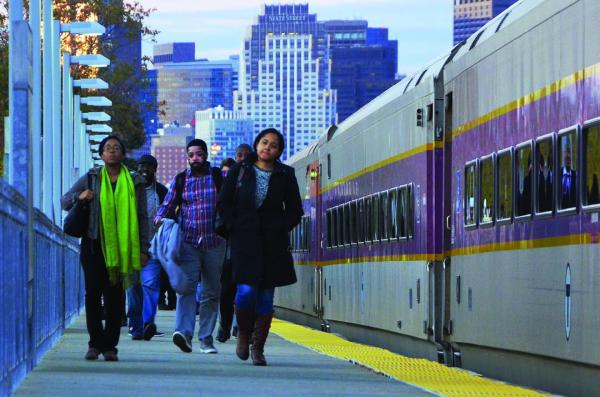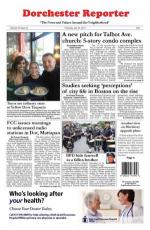March 14, 2018

The 9.2-mile-long Fairmount Line with its closely-spaced urban stations and existing high platforms makes it a “top target for electrification,” according to a new report by TransitMatters. Chris Lovett photo
The Fairmount Line is primed to be on the front end of a major commuter rail improvement, according to a new, in-depth report that advocates for an improved “regional rail” network. The sweeping report by the non-profit TransitMatters calls for a long-term overhaul to the regional system, with electrified rail, raised platforms, faster service, and other changes that would cost billions of dollars.
As laid out in the report, alterations to the statewide commuter rail network would bring the Fairmount line up to a nearly subway style standard of service, focusing on weekday peak travel times. TransitMatters wants station arrivals every 30 minutes in the suburbs and 15 in denser neighborhoods, like Dorchester and Mattapan.
The network should be electrified and the current trains replaced with self-propelled electric vehicles called electric multiple units, or EMUs, the report recommends. Raised station platforms would let people board level to the train, fare adjustments and transfers connectivity between the commuter rail, subways, and bus system would encourage broader use of the MBTA system.
And the first step should be transitioning the Fairmount Line, the report said.
The report notes that all but two of the Fairmount’s eight stations have high platforms, as recommended, and the short, 9.2-mile line with its closely-spaced stations makes the high acceleration rates of EMUs “especially useful.” It’s connection to the Providence Line means it could make use of the existing electrical substations, reducing costs, and “should be the top target for electrification.”
An ongoing effort to add infill stops, like the under-construction Blue Hill Avenue station, to the line is a model for other commuter rail lines, the report said.
Fairmount Line ridership increases are also proof-positive of the effectiveness of fare integration, TransitMatters notes. Ridership tripled on the Fairmount line since 2012, when most of the stations were placed in Zone 1A, comparable to a subway fare. The line should have better integration with subway and bus fares, the report notes.
Allentza Michel, the Fairmount Indigo Network Coordinator with the Local Initiatives Support Corporation, said she is feeling “very positive in general about the focused attention on the Fairmount Line and the push to bring more transit which would lead to increased opportunities in communities.”
However, she wants to ensure that Fairmount Line improvements “are paired with other policies to improve more equitable development and anti-displacement practices in the corridor.”
The TransitMatters report echoes some of the longstanding requests from city advocates, Michel noted, including the push to electrify lines and include more efficient vehicles to serve a corridor disproportionately burdened with health risks from environmental congestion.
Diesel Multiple Unit (DMU) trains have been floated for the Fairmount before to ease its transition to rapid transit. Gov. Deval Patrick’s administration ordered the new vehicles, but the purchase was scuttled by Gov. Charlie Baker’s administration, with officials saying that the investment is now on hold indefinitely.
The regional rail report recommends starting to lease DMUs on routes like the Fairmount to speed up service before electrification. Subsequent EMUs would be faster still, averaging 30 miles per hour on the Fairmount and up to 55 miles per hour on other longer lines.
“The MBTA should lease DMUs, if possible, to immediately improve service on the Fairmount Line until electrification can be completed,” according to the report. “This is appropriate given the long history of social justice issues tied to the corridor, whose residents have not received equitable and reliable mobility.”
Electrification of the Providence, Stoughton, and Fairmount Lines should begin “as soon as possible, ideally within this decade,” TransitMatters said.
Frequent local service should follow, with trains at least every 15 minutes at rush hour and every 30 minutes off-peak on each branch. Fairmount and the inner ends of some other lines could provide “supplemental service,” every 10 minutes at peak and every 15 minutes off-peak.
This recommendation outstrips even some ambitious proposals from the city and state politicians. State Rep. Evandro Carvalho filed a bill in Jan. 2017 calling for a two-year pilot evaluation of the Fairmount as a rapid transit line. He called for increasing the number of cars on the route, rebranded as the Indigo Line, to bring at peak arrivals to every 15 minutes and off-peak to 30 minutes. The bill, however, has not gained much traction on Beacon Hill.
This week, Carvalho lauded the TransitMatters recommendations for the Fairmount, adding, “In particular, increased frequency would turn this line into a true gem, and doing so by electrifying the system would bring us closer to that reality in a sustainable and environmentally friendly manner.”
State Rep. Nick Collins, who is running largely uncontested to become the state senator for the First Suffolk District, said he is “in strong support” of the legislation to bring about a Fairmount pilot, of which he is a co-sponsor.
“Direct access to the job centers downtown and to the waterfront is critical.”
Re-opening discussions on DMUs is also a priority, he said, continuing the Deval Patrick administration’s investment in the line.
Mayor Martin Walsh last year said he would in the near term set up a Fairmount Line pilot on the city side using existing equipment and infrastructure that would not require large capital expenditures such as electrification. The city is working with MassDOT and the MBTA to design the pilot. GoBoston 2030 also recommends a transition to rapid transit along the Fairmount, the only commuter rail line to operate totally within city limits.
MBTA spokesman Joe Pesaturo said the TransitMatters team met with state transportation leaders, and “we greatly appreciate their hard work and strong advocacy for a convenient and reliable public transportation system that will serve the region’s needs for decades to come.”
An 18-month state-funded Commuter Rail Vision study launched last year is underway and considering many of the suggested options to improve the rail network — like full or partial system electrification; a change in vehicle technology to EMUs or other lower emitting and more flexible rolling stock; double or triple tracking, including any associated right of way acquisition; and new facilities and infill stations — as well as an assessment of modern rail networks in comparable urban areas.



